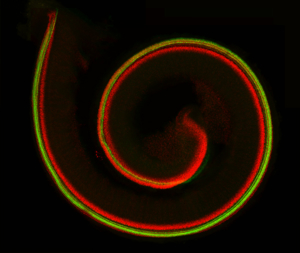 It turns out that to hear a person yapping, you need a protein called Yap. Working as part of what is known as the Yap/Tead complex, this important protein sends signals to the hearing organ to attain the correct size during embryonic development, according to a new study published in the Proceedings of the National Academy of the Sciences (PNAS) from the USC Stem Cell laboratory of Neil Segil.
It turns out that to hear a person yapping, you need a protein called Yap. Working as part of what is known as the Yap/Tead complex, this important protein sends signals to the hearing organ to attain the correct size during embryonic development, according to a new study published in the Proceedings of the National Academy of the Sciences (PNAS) from the USC Stem Cell laboratory of Neil Segil.
“Our study provides insights into how the hearing organ develops in utero, and offers clues about how to regenerate damaged cells to restore hearing later in life,” said lead author Ksenia Gnedeva, who performed the research during her postdoctoral training in the Segil Lab, and recently accepted a position as an assistant professor in the USC Tina and Rick Caruso Department of Otolaryngology – Head and Neck Surgery.
As the Organ of Corti forms in the embryonic mouse, a population of progenitor cells self-renews and proliferates to achieve the correct size. Then, after approximately two weeks, the progenitor cells begin differentiating into various specialized cell types.
The scientists found that the Yap/Tead protein complex plays a major role in this intricate developmental process by regulating the activity of hundreds of genes that control self-renewal and proliferation.
The Yap protein serves as a key signal to promote the proliferation of the progenitor cells during the first two weeks of development. If Yap signaling drives proliferation for longer than two weeks, then the inner ear sensory organs grow too large. If Yap signaling breaks down prematurely, then the Organ of Corti ends up being too small.
By the time mice are born, the progenitor cells in the Organ of Corti have finished both proliferation and differentiation, and cannot regenerate if they are damaged—causing permanent hearing loss.
Remarkably, when the scientists activated Yap in newborn mice with hearing loss, some of the cells in the Organ of Corti began proliferating again, suggesting that regeneration might be possible.
“This study provides the first support for the possibility of restoring lost sensory cells for hearing and balance by activating Yap in mice,” said Segil, Professor of Stem Cell Biology and Regenerative Medicine, and the USC Tina and Rick Caruso Department of Otolaryngology – Head and Neck Surgery. “Although we can’t permanently activate Yap in human patients for a variety of practical reasons, we might be able to locally administer a drug targeting related groups of molecules.”
Additional co-authors include: Xizi Wang, Litao Tao, Talon Trecek, Juan Llamas, and Welly Makmura from USC; Melissa M. McGovern and Andrew K. Groves from Baylor College of Medicine; Matthew Barton and Mark Warchol from Washington University in St. Louis; Tanner O. Monroe from Lurie Children’s Hospital of Chicago; and James F. Martin from the Baylor College of Medicine and Texas Heart Institute.
Ninety-five percent of this work was supported by federal grants from the National Institute on Deafness and Other Communications Disorders (R21DC016984, T32DC009975, T32DC000022, F31DC017376, R01DC006283, DC014832, R01DC015829, T32DC009975), and the National Institutes of Health (HL127717, HL130804, HL118761). The remainder of the funding came from non-federal sources including the Vivian L. Smith Foundation, State of Texas funding, Fondation LeDucq Transatlantic Networks of Excellence in Cardiovascular Research (14CVD01), and the Hearing Restoration Program of the Hearing Health Foundation.